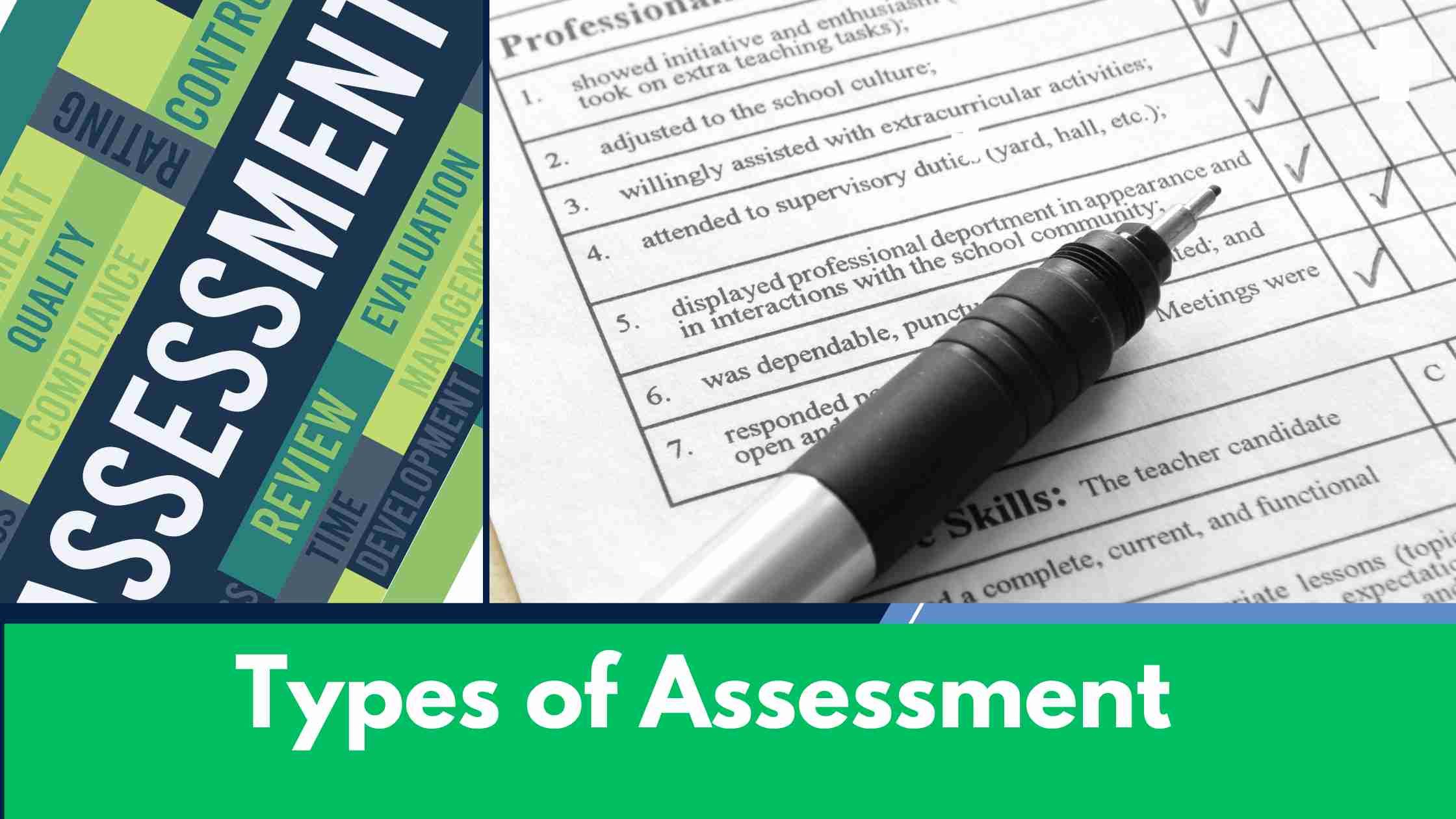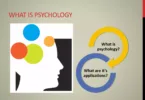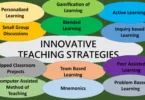Assessment is a major component of the educational process, facilitating student learning and improving instruction quality. It can be categorized into three main types:
- Assessment For Learning
- Assessment of learning
- Assessment as learning
Each type serves a distinct purpose and provides valuable insights into students’ progress and achievements.
Assessment for learning, or formative assessment, is an ongoing and continuous process that allows teachers to monitor students’ performance daily. Its primary objective is to provide timely and specific feedback to students, enabling them to enhance their learning. This type of assessment plays a pivotal role in shaping instructional strategies, as teachers can modify their teaching methods based on individual student needs. Using formative assessment, teachers can make informed decisions and guide students toward success.
On the other hand, assessment of learning focuses on making summative judgments about students’ achievements. It is a final evaluation of students’ knowledge and skills, determining their overall performance and progress. Unlike formative assessment, which is used to inform instruction, assessment of learning is more akin to judgment. It allows teachers to assign grades or determine a student’s competency in a particular subject. This type of assessment is often used to provide a comprehensive overview of a student’s abilities and to determine their readiness for further academic pursuits.
Lastly, Assessment As Learning involves students actively participating in the assessment process.

Assessment for Learning (Formative Assessment
Formative assessment, also known as assessment for learning, plays a crucial role in identifying areas needing improvement. Various types of formative assessment can be employed to gather valuable feedback on student progress. Observations during in-class activities and non-verbal feedback during lectures provide valuable insights into students understanding. Homework exercises and class discussions serve as effective tools for review and reinforcement. Reflection journals, question-and-answer sessions, conferences, and in-class presentations also contribute to the formative assessment process. Additionally, student feedback, collected through periodic evaluations, allows for self-reflection and evaluation of performance and progress.
Definition of Assessment for Learning
Formative assessment is integral to the learning process, focusing on identifying areas that require improvement. It involves ongoing assessment and feedback that helps students understand their strengths and weaknesses, thus guiding them towards achieving their learning goals. This assessment provides valuable information to teachers and students, allowing for instruction and learning strategy adjustments.
To further understand the concept of formative assessment, let’s explore a table that highlights its key characteristics:
| Characteristics | Explanation |
|---|---|
| Ongoing | Formative assessment is conducted throughout the learning process, enabling continuous monitoring of student progress. It provides timely feedback to guide further learning. |
| Feedback-oriented | The primary purpose of formative assessment is to provide constructive feedback to students, focusing on their areas of improvement. It helps students understand their strengths and weaknesses and encourages self-reflection. |
| Diagnostic | Formative assessment aims to diagnose students’ understanding and knowledge gaps. It helps teachers identify areas where additional support or instructional strategies are required. |
A primary focus of formative assessment is identifying areas needing improvement. This type of assessment allows instructors to gather information and provide feedback to students to guide their learning progress. Examples of formative assessment methods include:
Examples of Assessment for Learning
One common example of formative assessment is observation during in-class activities. By observing students’ behavior, level of engagement, and non-verbal feedback during lectures, instructors can gain insights into students’ understanding of the material and identify areas needing further clarification.
Homework exercises can also serve as formative assessments. Assignments designed to review topics covered in class can help students reinforce their learning and identify any misconceptions they may have.
Reflection journals are another effective formative assessment tool. These journals, reviewed periodically during the semester, allow students to reflect on their learning experiences, identify strengths and weaknesses, and set improvement goals.
Question and answer sessions allow students to actively engage with the material and clarify any uncertainties they may have. These sessions can be formal and planned activities or spontaneous interactions between the instructor and students.
Another form of formative assessment is conferences between the instructor and students.
Types of Formative Assessment
Formative assessment encompasses various methods and techniques instructors can employ to gauge students’ understanding and progress throughout the learning process. These assessments provide valuable feedback that can guide instructional decisions and help identify areas for improvement. Let’s explore some common types of formative assessment:
1. Observations during in-class activities: By closely observing students’ participation and engagement, instructors can gain insights into their understanding and identify any misconceptions or areas of confusion.
2. Homework exercises as review: Assigning homework exercises that align with the course material can be a form of formative assessment. Instructors can review students’ solutions and provide feedback to address misunderstandings before exams or class discussions.
3. Reflection journals: Periodically reviewing students’ reflection journals allows instructors to assess their understanding, self-reflection, and progress. These journals provide a platform for students to express their thoughts, insights, and questions about the course content.
4. Question and answer sessions: Both planned formal questions and spontaneous interactions between instructors and students can be used for formative assessment. These sessions enable instructors to gauge students’ comprehension, clarify concepts, and address doubts or misconceptions.
Assessment of Learning (Summative Assessment)
Assessment of learning, or summative assessment, is a crucial component of the educational process. Examinations are a common form of summative assessment, especially high-stakes exams determining a student’s final grade or certification. Another form of summative assessment is the final examination, which evaluates a student’s comprehensive understanding of the course material. On the other hand, term papers are considered formative assessments as they are submitted throughout the semester, allowing students to receive feedback and make improvements. Projects and portfolios can also be assessed formatively during their development stages.
Definition of Assessment of Learning (Summative Assessment)
Transitioning from the previous section on Assessment for Learning, we now delve into the concept of Assessment of Learning, also known as Summative Assessment. This assessment form aims to evaluate students’ learning and achievement at the end of a unit, course, or program. Unlike formative assessment, which focuses on providing feedback to improve learning, summative assessment finalizes the extent of students’ knowledge and skills.
Definition: Summative assessment is a method used to measure students’ learning outcomes and determine their level of proficiency or achievement. It is typically administered after students have completed a period of instruction, such as a unit or semester. The results of summative assessments are often used for grading purposes or to make decisions about students’ readiness for advancement or graduation.
To further understand the concept of summative assessment, let’s explore some examples along with their usage in educational settings:
| Examples | Usages |
|---|---|
| Examinations | Major exams, including high-stakes assessments, are commonly used to assess students’ knowledge and understanding of the subject matter. |
Examples of Assessment of Learning (Summative Assessment)
Transition: Now that we have discussed assessment for learning (formative assessment), let’s explore the concept of assessment of learning (summative assessment) in more detail.
Definition: Assessment of learning refers to the evaluation of a student’s knowledge and skills at the end of a learning period or course. It is typically used to measure the overall achievement and provide a final judgment about a student’s performance. Unlike formative assessment, which focuses on providing feedback for improvement, summative assessment aims to summarize and certify the level of learning that has been achieved.
Examples: Some common examples of summative assessments include:
- Examinations (major, high-stakes exams): These formal assessments are administered at the end of a course or academic period. They typically cover a wide range of topics and are often used to determine a student’s overall grade or level of proficiency.
- Final examination: This is a comprehensive assessment that covers the content taught throughout the entire course. It is usually conducted under controlled conditions and significantly determines a student’s final grade.
- Term papers: Although drafts submitted throughout the semester can serve as formative assessments, the final submission of a term paper can be considered a summative assessment.
Usages of Assessment of Learning (Summative Assessment)
Summative assessment evaluates and measures student learning at the end of an instructional period. Unlike formative assessment, which monitors student progress and provides feedback for improvement, summative assessment focuses on determining the extent to which students have achieved the intended learning outcomes. It is typically used to assign grades or determine promotion to the next level.
The usages of summative assessment are diverse and can include:
- High-stakes exams: These are major assessments that often have significant consequences for students, such as determining college admissions or eligibility for professional certifications.
- Final examination: A comprehensive test administered at the end of a course or academic year to assess overall knowledge and understanding.
- Term papers: While drafts submitted throughout the semester can serve as formative assessments, the final version of a term paper can be used as a summative assessment to evaluate students’ research and writing skills.
- Projects: Assessing project phases submitted at various completion points can provide valuable feedback and inform instruction. However, the completion of a project can also be used as a summative assessment to evaluate the application of knowledge and skills.
Assessment as Learning (Self Assessment)
Assessment As Learning (Self Assessment) is a process where students actively evaluate their learning progress. Definition: Self-assessment involves students reflecting on their strengths and weaknesses, setting goals, and monitoring their progress. Examples: Students can assess their understanding by completing quizzes or self-reflective tasks. They can also evaluate their work through self-assessment portfolios or rubrics. Usages: Self-assessment encourages students to take ownership of their learning and develop metacognitive skills. It promotes critical thinking and problem-solving abilities.
Definition of Assessment As Learning (self-assessment)
Assessment as learning is a powerful strategy that empowers students to take ownership of their learning. Through self-assessment, students actively reflect on their progress and identify areas for improvement. This form of assessment goes beyond traditional evaluation methods and places the learning responsibility on the students.
Self-assessment can be defined as the process in which students assess their learning progress and understand their strengths and weaknesses. It involves students analyzing their work and providing feedback to themselves based on established criteria or learning goals. This process encourages students to become reflective learners and helps them develop metacognitive skills.
To better understand the concept of self-assessment, let’s take a look at the following table:
| Self-Assessment Benefits | Examples |
|---|---|
| Encourages self-reflection | Reflecting on personal strengths and weaknesses |
| Promotes autonomy | Setting personal learning goals and evaluating progress |
| Develops critical thinking | Analyzing one’s own work and identifying areas for improvement |
| Enhances self-efficacy | Recognizing personal growth and accomplishments |
Self-assessment can take various forms, such as journaling, self-evaluations, or self-scoring rubrics.
Examples of Assessment As Learning (Self Assessment)
In education, assessment as learning is an integral approach that empowers students to actively participate in their learning process. By engaging in self-assessment, students develop metacognitive skills, enabling them to analyze and reflect on their learning progress. This assessment focuses on students’ ability to connect prior knowledge with new information, fostering critical thinking and lifelong learning.
Examples of assessment as learning include:
| Assessment Method | Description | Benefits |
|---|---|---|
| Rubrics | Clear criteria are provided to guide self-evaluation | Enhances self-awareness and clarity of learning objectives |
| Learning Journals | Personal reflections on learning experiences | Encourages self-reflection and deepens understanding |
| Checklists | Structured lists to assess learning progress | Helps students track their growth and identify areas of focus |
These examples demonstrate how self-assessment can be implemented in various forms, allowing students to monitor their learning journey actively. By utilizing these methods, students can better identify areas for improvement and make necessary adjustments to their understanding.
Moreover, self-assessment can be further strengthened by incorporating peer assessment.
Usages of Assessment As Learning (Self Assessment)
Assessment as learning, specifically self-assessment, is widely used in educational settings to foster students’ metacognitive skills and promote their development as lifelong learners. Through self-assessment, students actively evaluate their learning and progress, allowing them to understand their strengths and areas for improvement better.
Usages
Self-assessment serves various purposes in education, supporting students’ learning and growth in several ways:
| Benefits | |
|---|---|
| 1. | Promoting Ownership of Learning: Students become active participants in their learning journey by taking responsibility for their assessment. They develop a sense of ownership and accountability, which drives them to take initiative and strive for improvement. |
| 2. | Promoting Ownership of Learning: By taking responsibility for their assessment, students become active participants in their learning journey. They develop a sense of ownership and accountability, which drives them to take initiative and strive for improvement. |
| 3. | Developing Metacognitive Skills: Self-assessment enables students to think critically about their learning processes, strategies, and goals. |
Conclusion
In conclusion, assessments are crucial in the education system as they provide valuable information about students’ learning progress and help educators make informed decisions about their teaching methods. Three main types of assessment serve different purposes and offer unique benefits.
Formative assessment, or assessment for learning, is an ongoing process that provides immediate feedback to students and teachers. It allows educators to monitor students’ understanding and adjust their instruction accordingly. For example, teachers may use classroom observations or informal quizzes to gauge students’ comprehension and identify areas where additional support is needed. By focusing on feedback and improvement rather than grades, formative assessment promotes a growth mindset and encourages students to participate in their learning actively.
Summative assessment, also referred to as assessment of learning, is typically used to evaluate students’ mastery of specific skills or knowledge after a period of instruction. Examples of summative assessments include standardized tests and final exams. These assessments provide a snapshot of students’ overall performance and are often used for accountability. While summative assessments are important for measuring achievement and making important decisions such as promotion or graduation, it is essential to remember that they should not be the sole determinant of a student’s abilities.
Lastly, self-assessment or assessment as learning empowers students to reflect on their learning progress and take responsibility for their academic growth.







